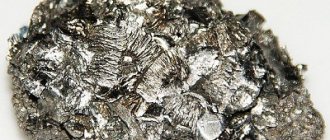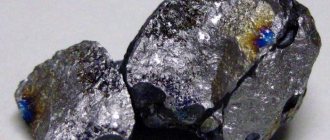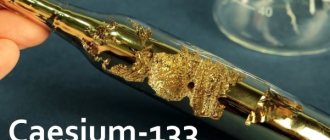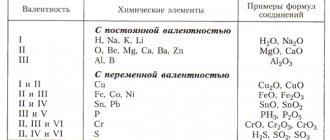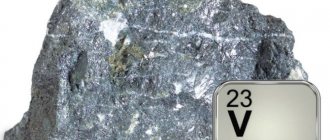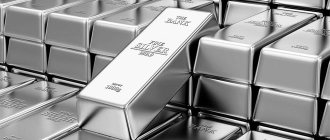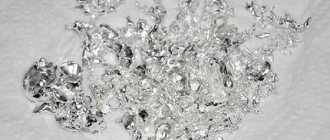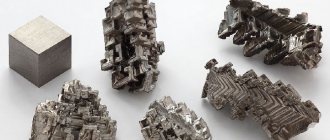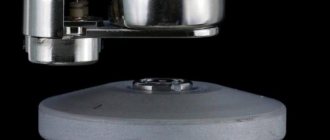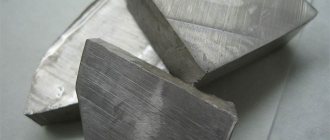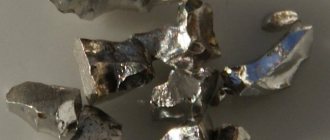| Iridium | |
| Atomic number | 77 |
| Appearance of a simple substance | |
| Properties of the atom | |
| Atomic mass (molar mass) | 192.22 a. e.m. (/mol) |
| Atomic radius | 136 pm |
| Ionization energy (first electron) | 868.1 (9.00) kJ/mol (eV) |
| Electronic configuration | [Xe] 4f14 5d7 6s2 |
| Chemical properties | |
| Covalent radius | 127 pm |
| Ion radius | (+4e) 68 pm |
| Electronegativity (Pauling) | 2,20 |
| Electrode potential | Ir←Ir3+ 1.00 V |
| Oxidation states | 6, 4, 3, 2, 1, 0, −1 |
| Thermodynamic properties of a simple substance | |
| Density | 22,5 /³ |
| Molar heat capacity | 25.1 J/(mol) |
| Thermal conductivity | 147 /(·) |
| Melting temperature | 2683 |
| Heat of Melting | 27.61 kJ/mol |
| Boiling temperature | 4403 |
| Heat of vaporization | 604 kJ/mol |
| Molar volume | 8.54 ³/mol |
| Crystal lattice of a simple substance | |
| Lattice structure | cubic face-centered |
| Lattice parameters | 3,840 |
| c/a ratio | n/a |
| Debye temperature | 430,00 |
| Ir | 77 |
| 192,22 | |
| [Xe]4f145d76s2 | |
| Iridium | |
Iridium
- a chemical element with atomic number 77 in
the PSHE
periodic table, designated by the symbol Ir (ridium). Iridium is a very hard, refractory, silvery-white transition metal of the platinum group, which has a high density and is second only to osmium in this parameter. Has high corrosion resistance even at temperatures of 2000 °C.
Iridium was discovered in 1803 by the English chemist S. Tennant simultaneously with osmium, which were present as impurities in natural platinum delivered from South America. It got its name (Iris - rainbow) due to the varied colors of its salts.
Iridium, properties of the atom, chemical and physical properties.
Ir 77 Iridium
192.217(3) 1s2 2s2 2p6 3s2 3p6 3d10 4s2 4p6 4d10 4f14 5s2 5p6 5d7 6s2
Iridium is an element of the periodic system of chemical elements of D.I. Mendeleev with atomic number 77. It is located in the 9th group (according to the old classification - a secondary subgroup of the eighth group), the sixth period of the periodic system.
Iridium atom and molecule. Iridium formula. Structure of the iridium atom
Isotopes and modifications of iridium
Properties of iridium (table): temperature, density, pressure, etc.
Physical properties of iridium
Chemical properties of iridium. Iridium interaction. Chemical reactions with iridium
Obtaining iridium
Applications of iridium
Table of chemical elements D.I. Mendeleev
How do you get it?
We have already said that this metal is found only in alloys. But how is it possible to obtain iridium? The source of the rock is anode sludge from copper-nickel production. The product - sludge is saturated, after which, under the influence of “regia vodka”, it is transferred from a solid to a liquid state, in the form of chloride compounds H2[PtCl6].
As a result, chemists obtain a liquid mixture of metals and add ammonium chloride NH4Cl to it. After this, the precipitate is removed from the platinum, and then an iridium complex (NH4)2[IrCl6] is obtained. (NH4)2[IrCl6] is calcined with oxygen and nitrogen. The output is metallic iridium.
Iridium atom and molecule. Iridium formula. Structure of the iridium atom:
Iridium (Latin Iridium, from ancient Greek ἶρις - “rainbow”) is a chemical element of D. I. Mendeleev’s periodic system of chemical elements with the designation Ir and atomic number 77. Located in the 9th group (according to the old classification - secondary subgroup of the eighth group), the sixth period of the periodic table.
Iridium is a metal. Belongs to the group of transition metals, as well as precious metals and platinum group metals.
Iridium is designated by the symbol Ir.
As a simple substance, iridium under normal conditions is a very hard, refractory, silvery-white metal.
The iridium molecule is monatomic.
Chemical formula of iridium Ir.
The electronic configuration of the iridium atom is 1s2 2s2 2p6 3s2 3p6 3d10 4s2 4p6 4d10 4f14 5s2 5p6 5d7 6s2. The ionization potential (first electron) of the iridium atom is 865.19 kJ/mol (8.96702(22) eV).
Structure of the iridium atom. The iridium atom consists of a positively charged nucleus (+77), around which 77 electrons move through six shells. In this case, 75 electrons are in the internal level, and 2 electrons are in the external level. Since iridium is located in the sixth period, there are only six shells. First, the inner shell is represented by the s-orbital. The second - the inner shell is represented by s- and p-orbitals. The third and fifth – inner shells are represented by s-, p- and d-orbitals. The fourth - the inner shell is represented by s-, p-, d- and f-orbitals. The sixth - outer shell is represented by the s-orbital. At the internal energy level of the iridium atom in the 5d orbital there are four paired electrons and three unpaired electrons. At the outer energy level of the iridium atom, there are two paired electrons in the 6s orbital. In turn, the nucleus of an iridium atom consists of 77 protons and 115 neutrons. Iridium belongs to the elements of the d-family.
The radius of the iridium atom (calculated) is 180 pm.
The atomic mass iridium atom is 192.217(3) a. eat.
Iridium, along with osmium, has the highest density among all simple substances.
Iridium is the rarest metal on Earth. Its content in the earth's crust is 4.0×10-8%.
Iridium, properties of the atom, chemical and physical properties
Use, application of metal
The production of crystals is not complete without crucibles made of precious metal.
It is used in precision instrument parts and as a coating for electrical contacts.
In long-life spark plugs they are used as electrodes.
The advantage of such spark plugs is the lightning-fast acceleration of the engine and its stable operation. There is no risk of loss of spark; such spark plugs have excellent anti-corrosion properties. There is only one drawback - the price...
Metal is used for the “eternal” nibs of fountain pens.
Economical: in some countries, instead of expensive iridium, they use an alloy of niobium with rhenium - it is almost as wear-resistant, but in appearance it differs little from iridium. We recommend: BRASS - an alloy from the legendary Atlantis
Iridium is an excellent catalyst, like all its platinum metal relatives. However, the high price limits its use.
Organic synthesis is now impossible without iridium catalysts. Work on organic synthesis received the Nobel Prize in Chemistry. To make it clear, organic synthesis will make it possible to switch to “green chemistry”, abandon the use of fossil resources, and switch to renewable resources.
The kilogram standard is created from a platinum-iridium alloy and is stored in France.
Informative: don’t argue if you see in Russia, at the All-Russian Research Institute of Metrology, the international standard of the kilogram. 6 such copies of that French standard were made.
An alloy of iridium and titanium is used in deep-sea pipelines.
The Ir-192 isotope is used in flaw detectors and thickness gauges (portable).
Fabulous prospects for iridium in medicine
Pacemakers use an iridium-platinum alloy.
Oncologists use the iridium isotope Ir-192 as a source of gamma radiation. It is used to treat breast and prostate cancer (in the early stages of the disease).
Methods have been developed for the treatment of epilepsy, Parkinson's disease, and schizophrenia by introducing iridium electrodes into the brain. The method of implanting microelectrodes opens up bright prospects for creating prosthetic eyes and hearing aids.
Properties of iridium (table): temperature, density, pressure, etc.:
Detailed information on the website ChemicalStudy.ru
| 100 | General information | |
| 101 | Name | Iridium |
| 102 | Former name | |
| 103 | Latin name | Iridium |
| 104 | English name | Iridium |
| 105 | Symbol | Ir |
| 106 | Atomic number (number in table) | 77 |
| 107 | Type | Metal |
| 108 | Group | Precious, transition metal, platinum group metal |
| 109 | Open | Smithson Tennant, Great Britain, 1803 |
| 110 | Opening year | 1803 |
| 111 | Appearance, etc. | Very hard, refractory, silvery-white metal |
| 112 | Origin | Natural material |
| 113 | Modifications | |
| 114 | Allotropic modifications | |
| 115 | Temperature and other conditions for the transition of allotropic modifications into each other | |
| 116 | Bose-Einstein condensate | |
| 117 | 2D materials | |
| 118 | Content in the atmosphere and air (by mass) | 0 % |
| 119 | Content in the earth's crust (by mass) | 4,0·10-8 % |
| 120 | Content in seas and oceans (by mass) | |
| 121 | Content in the Universe and space (by mass) | 2,0·10-7 % |
| 122 | Abundance in the Sun (by mass) | 2,0·10-7 % |
| 123 | Content in meteorites (by mass) | 0,000054 % |
| 124 | Content in the human body (by weight) | |
| 200 | Properties of the atom | |
| 201 | Atomic mass (molar mass) | 192.217(3) a. e.m. (g/mol) |
| 202 | Electronic configuration | 1s2 2s2 2p6 3s2 3p6 3d10 4s2 4p6 4d10 4f14 5s2 5p6 5d7 6s2 |
| 203 | Electronic shell | K2 L8 M18 N32 O15 P2 Q0 R0 |
| 204 | Atomic radius (calculated) | 180 pm |
| 205 | Empirical atomic radius* | 135 pm |
| 206 | Covalent radius* | 141 pm |
| 207 | Ion radius (crystalline) | Ir 3+ 82 (6) pm, Ir 4+ 76.5 (6) pm, Ir 5+ 71 (6) pm (in parentheses the coordination number is indicated - a characteristic that determines the number of nearest particles (ions or atoms) in a molecule or crystal) |
| 208 | Van der Waals radius | |
| 209 | Electrons, Protons, Neutrons | 77 electrons, 77 protons, 115 neutrons |
| 210 | Family (block) | d-family element |
| 211 | Period in the periodic table | 6 |
| 212 | Group on the periodic table | 9th group (according to the old classification - a secondary subgroup of the 8th group) |
| 213 | Emission spectrum | |
| 300 | Chemical properties | |
| 301 | Oxidation states | -3, -1, 0, +1, +2, +3, +4, +5, +6, +7, +8, +9 |
| 302 | Valence | I, II, III, IV, V, VI |
| 303 | Electronegativity | 2.2 (Pauling scale) |
| 304 | Ionization energy (first electron) | 865.19 kJ/mol (8.96702(22) eV) |
| 305 | Electrode potential | Ir3+ + 3e– → Ir, Eo = +1.0 V |
| 306 | Electron affinity energy of an atom | 150.9086(12) kJ/mol (1.07780(13) eV) |
| 400 | Physical properties | |
| 401 | Density* | 22.56 g/cm3 (at 20 °C and other standard conditions , state of matter – solid), 19 g/cm3 (at melting point 2446 °C and other standard conditions , state of matter – liquid) |
| 402 | Melting temperature* | 2446 °C (2719 K, 4435 °F) |
| 403 | Boiling temperature* | 4130 °C (4403 K, 7466 °F) |
| 404 | Sublimation temperature | |
| 405 | Decomposition temperature | |
| 406 | Self-ignition temperature of a gas-air mixture | |
| 407 | Specific heat of fusion (enthalpy of fusion ΔHpl)* | 41.12 kJ/mol |
| 408 | Specific heat of evaporation (enthalpy of boiling ΔHboiling)* | 564 kJ/mol |
| 409 | Specific heat capacity at constant pressure | 0.131 J/g K (at 0-100 °C) |
| 410 | Molar heat capacity | 25.1 J/(K mol) |
| 411 | Molar volume | 8.52 cm³/mol |
| 412 | Thermal conductivity | 147 W/(mK) (at standard conditions ), 147 W/(mK) (at 300 K) |
| 500 | Crystal cell | |
| 511 | Crystal grid #1 | |
| 512 | Lattice structure | Cubic face centered |
| 513 | Lattice parameters | 3.840 Å |
| 514 | c/a ratio | |
| 515 | Debye temperature | 430 K |
| 516 | Name of space symmetry group | Fm_3m |
| 517 | Symmetry space group number | 225 |
| 900 | additional information | |
| 901 | CAS number | 7439-88-5 |
Note:
205* The empirical radius of iridium according to [1] and [3] is 136 pm.
206* The covalent radius of iridium according to [1] and [3] is 141±6 pm and 127 pm, respectively.
401* The density of iridium according to [3] and [4] is 22.65 / 22.56±0.01 g/cm3 (at 0 °C and other standard conditions , the state of matter is a solid) and 22.562 g/cm3 (at 20 °C and other standard conditions , the state of matter is a solid) respectively.
402* The melting point of iridium according to [3] and [4] is 2466 °C (2739 K, 4471 °F) and 2450 °C (2723.15 K, 4442 °F), respectively.
403* The boiling point of iridium according to [3] and [4] is 4428 °C (4701 K, 8002 °F) and 4380 °C (4653.15 K, 7916 °F), respectively.
407* The specific heat of fusion (melting enthalpy ΔHmelt) of iridium according to [3] and [4] is 26.0 kJ/mol and 26.4 kJ/mol, respectively.
410* The specific heat of evaporation (boiling enthalpy ΔHboil) of iridium according to [3] and [4] is 610 kJ/mol and 612.5 kJ/mol, respectively.
History of discovery
The history of the discovery of iridium is associated with the name of the British chemist Smithson Tennant. While examining platinum ore from the mines of South America (1803), he tried to isolate pure metal. By treating the ore with aqua regia, an insoluble residue was obtained. Substances unknown to science were discovered here. These were iridium and osmium.
The name came naturally. Tennant was impressed by the iridescence of the salts of the new metal, and he named it iridium.
Iris was the name of the ancient Greek goddess of the rainbow.
The scientist was elected a member of the Royal Society of London, and in 1804, for the discovery of osmium and iridium, he was awarded the Copley Medal, the society's highest award.
Interesting Facts
Iridium salts are very diverse in color. Thus, depending on the number of added chlorine atoms, the compound may have a copper-red, dark green, olive or brown color. Iridium difluoride is yellow in color. Compounds with ozone and bromine are blue in color. Pure iridium has very high corrosion resistance even when heated to 2000 degrees.
In rocks of terrestrial origin, the concentration of iridium compounds is very low . It seriously increases only in rocks of meteorite origin. This criterion allows researchers to establish important facts about various geological structures. Only a few tons of iridium are produced on earth.
The Young's modulus (also known as the longitudinal elastic modulus) of this metal is in second place among known substances (only graphene has more).
Sources
- https://chem.ru/iridij.html
- https://mysamocvet.ru/metally/iridij/
- https://ProDragmetally.ru/dragotsennye-metally/iridij.html
- https://himsnab-spb.ru/article/ps/ir/
- https://metallsmaster.ru/iridij/
- https://k-tree.ru/tools/chemistry/periodic.php?element=Ir
- https://TheMineral.ru/metally/iridij
- https://vplate.ru/metally-i-splavy/vse-ob-iridii/
- https://jgems.ru/metally/iridij
- https://calcsbox.com/post/iridium.html
